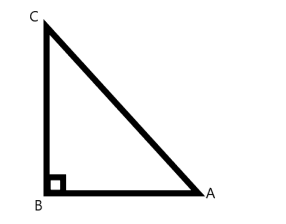
State Pythagoras Theorem?
Answer
476.7k+ views
Hint: This theorem is applied in a right angle triangle only, it states that the square of sum of two adjacent sides is equal to the sum of the largest third side.
Complete step-by-step answer:
As we have to state Pythagoras theorem.
Pythagoras' theorem states that for all right-angled triangles, 'The square of the hypotenuse is equal to the sum of the squares of the other two sides'. The hypotenuse is the longest side and it's always opposite the right angle.
Diagram:

Hence, we can see that the two adjacent sides here are AB, BC and the hypotenuse is AC.
Hence, we can write that the square of the hypotenuse is equal to the sum of squares of both adjacent sides.
Hence, it can be given as \[A{C^2} = A{B^2} + B{C^2}\] .
Thus, above is the Pythagoras theorem.
Additional Information:
Pythagoras theorem is also used in Architecture and Construction. Given two straight lines, the Pythagorean Theorem allows you to calculate the length of the diagonal connecting them. This application is frequently used in architecture, woodworking, or other physical construction projects.
Engineers and astronomers use the Pythagorean Theorem to calculate the paths of spacecraft, including rockets and satellites. Architects use the Pythagorean Theorem to calculate the heights of buildings and the lengths of walls.
Note: In mathematics, the Pythagorean theorem is a fundamental relation in Euclidean geometry among the three sides of a right triangle. It states that the area of the square whose side is the hypotenuse is equal to the sum of the areas of the squares on the other two sides.
Pythagoras' theorem only works for right-angled triangles, so you can use it to test whether a triangle has a right angle or not.
Complete step-by-step answer:
As we have to state Pythagoras theorem.
Pythagoras' theorem states that for all right-angled triangles, 'The square of the hypotenuse is equal to the sum of the squares of the other two sides'. The hypotenuse is the longest side and it's always opposite the right angle.
Diagram:

Hence, we can see that the two adjacent sides here are AB, BC and the hypotenuse is AC.
Hence, we can write that the square of the hypotenuse is equal to the sum of squares of both adjacent sides.
Hence, it can be given as \[A{C^2} = A{B^2} + B{C^2}\] .
Thus, above is the Pythagoras theorem.
Additional Information:
Pythagoras theorem is also used in Architecture and Construction. Given two straight lines, the Pythagorean Theorem allows you to calculate the length of the diagonal connecting them. This application is frequently used in architecture, woodworking, or other physical construction projects.
Engineers and astronomers use the Pythagorean Theorem to calculate the paths of spacecraft, including rockets and satellites. Architects use the Pythagorean Theorem to calculate the heights of buildings and the lengths of walls.
Note: In mathematics, the Pythagorean theorem is a fundamental relation in Euclidean geometry among the three sides of a right triangle. It states that the area of the square whose side is the hypotenuse is equal to the sum of the areas of the squares on the other two sides.
Pythagoras' theorem only works for right-angled triangles, so you can use it to test whether a triangle has a right angle or not.
Recently Updated Pages
Express the following as a fraction and simplify a class 7 maths CBSE

The length and width of a rectangle are in ratio of class 7 maths CBSE

The ratio of the income to the expenditure of a family class 7 maths CBSE

How do you write 025 million in scientific notatio class 7 maths CBSE

How do you convert 295 meters per second to kilometers class 7 maths CBSE

Write the following in Roman numerals 25819 class 7 maths CBSE

Trending doubts
When people say No pun intended what does that mea class 8 english CBSE

In Indian rupees 1 trillion is equal to how many c class 8 maths CBSE

How many ounces are in 500 mL class 8 maths CBSE

Which king started the organization of the Kumbh fair class 8 social science CBSE

What is BLO What is the full form of BLO class 8 social science CBSE

Advantages and disadvantages of science




